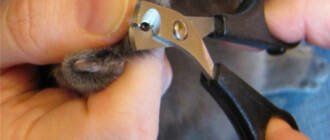Tremor in cats is a convulsive contraction of the muscles of the animal's body, which is visually expressed as a fine tremor. Sometimes a cat's entire body trembles, but individual areas may also shake. Involuntary contraction of the muscles, called tremor, may also occur at complete rest, indicating maximum relaxation of all muscle groups. However, trembling, often indicates that the cat has a serious health problem and the animal requires urgent treatment.
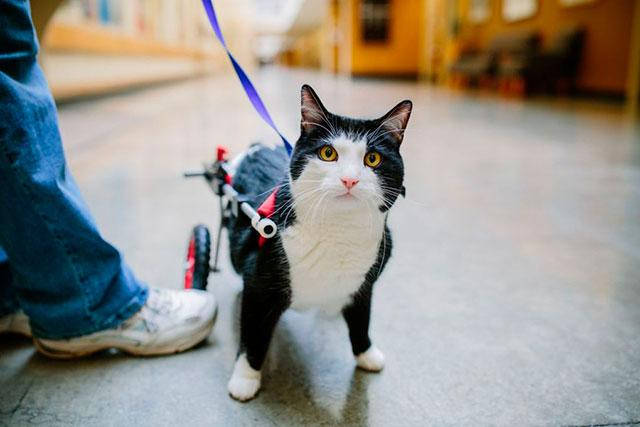
- Why a cat shivers
- Causes for cat tremors
- Physiological shaking
- Pathological causes
- Pathological causes of trembling
- Heatstroke
- Viral and bacterial diseases
- Parasite infestation
- Vitamin and micronutrient deficiencies
- Q&A
- When will you need to see a veterinarian
- Reasons why a cat may have shaky hind legs
- Diagnosis and treatment
- Diagnosis
- Treatment
- Diagnosis
- Methods of treatment
- Physical therapy treatments that can be prescribed by a doctor
Why a cat shivers
Shivering in a pet is a signal that there are some processes going on in the body. The tremor can be large or small and sometimes not quite noticeable under a thick coat. You can feel such a symptom if you put your hand on the cat.
There are many reasons why the cat trembles, but it is impossible not to notice it. If you notice that the cat has chills or shivers in the body, you need to understand what caused it. It may be the common cold, or it may be a more serious internal pathology.
It is worth remembering that you can't do without a qualified veterinarian, because it is impossible to determine the exact cause of shivering in a cat.
Causes for cat tremors
Trembling, or in other words, tremor, a condition that indicates the contraction of muscle fibers. If the cat trembles, it does not always indicate the development of pathology. The main causes of shivering in a cat are:
- The body's specific reaction to the cold . The cat may tremble after bathing or after long walks outside in the cold season. The tremor may be caused by serious hypothermia when spending a long time outdoors, as well as a slight drop in temperature when it is cool indoors. You can prevent shivering in the pet's body as a result of hypothermia by avoiding long walks of the pet in the cold. Cats with short hair or hairless breeds are particularly prone to shivering. Owners of such pets should take better care of their animals.
- Stress condition. Tremors in a cat can appear as a response to a strong emotional outburst or stress. The appearance of tremors in a cat can be associated with the arrival of new animals in the house, when transporting the pet in a carrier. In this case, the cat's tail shakes, so the animal signals its nervous state. The shaking can be eliminated by preventing the cat from developing stress and calming it down as much as possible.
- Sexual excitement . During the period of sexual hunt in a cat against the background of a hormonal surge, a characteristic trembling may occur. During heat a cat's senses are all heightened, they react more vividly to various smells, and may behave strangely and restlessly. It is possible to prevent this condition in a cat by timely surgical intervention to remove the reproductive function.
- Natural biochemical processes in the body . While the animal is resting, the body continues its work. Biological processes are active in the body of a sleeping cat, accompanied by shivering in sleep in the whole body, or some parts. Thus, it has been noticed that not only dogs, but also cats are able to shake their hind legs in their sleep.
Physiological shaking
Physiological trembling in cats does not occur very often, but still occurs, and treatment of this condition is not required. Most often in this situation, the cat's paw tremor may start first, and then the tremor from the hind limbs gradually spreads to the back of the pet and sometimes completely takes over the whole body. The main natural causes of shivering in a cat are:
- Strong excitement with frequent lifting on hind legs – usually this behavior is observed when the cat smells a favorite treat on the table. The cat tries by all means to show its owner that it needs a treat, without which it simply cannot live. Excitement and a strong tension on its hind paws, on which the cat is constantly raised, cause the cat to shiver, which passes within 10-15 minutes. The condition is not dangerous and is completely natural;
- Prolonged exposure to the cold – if a cat that walks freely in the street has been sitting in an ambush for a long time in the cold season, it can easily develop tremors in its hind paws. It is in them from exposure to low temperatures that blood circulation is disturbed the most. In such a situation, trembling is necessary in order to restore blood circulation as soon as possible. As soon as the animal's blood flow is restored, the shivering will go away. This is not a cause for concern unless, of course, the cat is severely overfrozen and there is no threat of a cold;
- Strong sexual excitement in a cat – this phenomenon is noted in case the young cat smells a hot cat, but has no access to it. The animal begins to actively search for the female, meows loudly, and its paws begin to twitch slightly due to excitement. Most often it is the hind paws that are affected by the phenomenon, because of their proximity to the genitals, and therefore an excited cat on shaky legs in this situation – does not look and is not sick. Front paws and head usually do not shake.
- Frightened – sometimes it is not clear to the owner, for example, when the cat starts trembling as if for no reason, sitting on the window sill. The problem is not ill at all, but with the fact that she saw an unfamiliar cat or dog.
Pathological causes
Paws shake most often when the cat's body is infected with herpes virus or when laryngotrocheitis develops. The main symptoms of such pathologies, in addition to the fact that the cat's hind paws tremble, are:
Shivering in the paws can appear and because of neglected helminthiasis or cystitis. In such a situation, paw tremors are aimed at relieving discomfort in the abdominal cavity. Treatment for the appearance of abnormal shivering should be carried out urgently. Postpone it for days, and moreover – for a month, is unacceptable, as because of this may be a threat to the life of the pet. The help of a veterinarian will be necessary.
Pathological causes of trembling
Sometimes body shivering is accompanied by secondary symptoms. The overall health of the cat may suffer. In this situation, you can not do without the help of a veterinarian. What to pay attention to in such a situation and how to understand that your pet is not healthy?
Heatstroke

An elevated body temperature in a cat can occur as a result of heat stroke. This condition usually occurs in the summertime.
In addition to the tremor, the pet may have symptoms such as:
If a high fever occurs, it is important to get the pet to a clinic as soon as possible. To reduce the fever, wet towels can be placed under the cat. It is very important to ensure that the cat has a full drinking regimen. Water can be injected into the mouth with a syringe.
Viral and bacterial diseases
Tremor can accompany diseases such as rhinotracheitis or calicivirosis.
Antibiotics and antiviral drugs are used for treatment. A sick animal is isolated from healthy animals. The duration of therapy is determined individually.
Parasite infestation
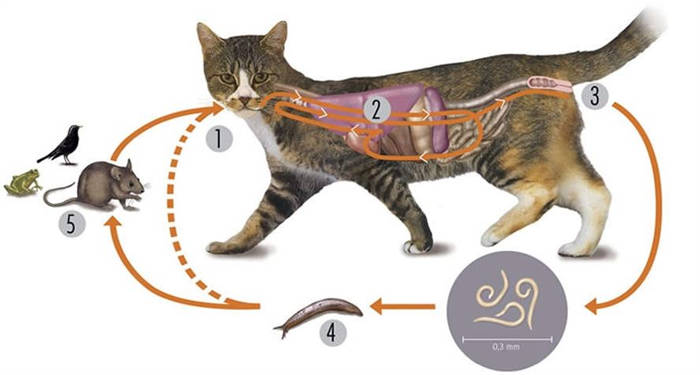
Advanced worm infestations are the cause of severe intoxication of the cat's body. Body shivering can be a reaction to the presence of worms. Most often, cats suffer from cestodes, ascarids, nematodes.
Worm infestations are treated with medication. Pills, injections or suspensions are used for this purpose. It is also necessary to carry out regular prophylaxis against parasites, especially if the cat is outdoors.
Vitamin and micronutrient deficiencies
Shivering can indicate a deficiency of B vitamins and calcium. As a result of the deficiency there are degenerative processes in the muscle tissue, which provokes the development of tremor. Vitamin deficiencies can be determined with a general blood test. To solve the problem, the cat is prescribed special vitamins, medications or special food.
Q&A
Since the tremor is only a symptom, it is important to find out the root cause of the pathological condition and direct forces to eliminate it.
No, tremor is a symptom that occurs in response to processes occurring in the body or in the environment. The tremor itself is not dangerous to health.
A cramp is an involuntary contraction of the muscles of the body. At the same time the cat cannot control itself.
If the body tremor does not go away within a few hours, even though all external factors have been eliminated, show the cat to the veterinarian. The tremor may be a symptom of a dangerous disease.
If the tremor is caused by external factors or physiological reasons, eliminating the irritants is sufficient. If there are additional symptoms, see a specialist.
When will you need to see a veterinarian
In the event that the owner, after analyzing the trembling of his pet on his own did not find an explanation for it, he will need to immediately contact the nearest veterinary clinic to a specialist. With the occurrence of trembling in the pet, its behavior may also change, overnight the beloved cat may become aggressive. In addition to the reasons described above, there are many other less innocuous causes of cat tremors while lying down.
The veterinarian will send the animal together with the owner for all the necessary tests and internal organ ultrasound, and then make recommendations on the necessary treatment.
Reasons why a cat may have shaky hind legs
Tremors in the pelvic limbs in cats at rest may indicate severe emotional distress. Evidence of such a condition in males, can be a period of puberty. At this time, the body of the pet undergoes changes, there is a restructuring.
Professional breeders assure that after the first mating or after a surgical operation to remove the reproductive function (castration), such tremors from sexual overexcitation disappear. If the tremor does not go away, it means that the cause is different, and without the help of a veterinarian cannot do without it.
Acute vitamin B deficiency may be the cause of hind limb tremors. Serious changes in the nervous system occur, leading to tremors in the cat's limbs, even at complete rest. It is necessary to prescribe medications in the form of pills or injections. After the vitamin deficiency is restored, the cat's hind legs stop shaking.
The occurrence of shaking in the hind legs is also provoked by an acute lack of calcium in the pet's body. The duration of these spasms is short, and the cat does not feel uncomfortable. This is an alarming sign of calcium deficiency, which must be urgently replenished. It is recommended to introduce more foods containing this nutrient into the diet. After 1.5-2 weeks, the balance normalizes and the tremor in the extremities stops.
Prolonged calcium deficiency removes all systems, including teeth and bone structures. Brittle bones develop, teeth deteriorate.
Pathologies of the renal system may be the cause of paw tremors. When such pathological conditions develop, the tremor in the paws lasts for a long time and may occur suddenly when the animal makes even minor movements. This causes discomfort and, in addition, the genitourinary system is affected. Without timely assistance from a veterinarian, the disease can lead to the death of the pet.
Diagnosis and treatment
There are enough factors that provoke the appearance of tremors in the limbs. These can be both physiological and pathological factors. Noticing that the cat is shivering, you must first rule out harmless factors – hypothermia, fear or sexual excitement.
You can try to warm the cat if it is cold, calm the cat when it is frightened. If the cat's paws are shaking as a result of sexual excitement, the only way to eliminate this is to have the pet spayed.
Self-prescription of medications, even herbal ones, can provoke dangerous complications.
If the cat is under stress, you need to pay more attention to the animal. In more dangerous cases, it is recommended to go to a veterinary clinic. At the examination, the doctor is sure to collect the anamnesis, as well as prescribe a number of laboratory and instrumental tests. Conducted:
- general blood test – necessary to detect processes of inflammatory nature in the body of the animal;
- Ultrasonic diagnostics – makes it possible to detect pathologies in the digestive tract;
- X-ray examination – allows us to visualize problems in bone structures.
Diseases of the endocrine system or the gastrointestinal tract, are treated after determining the exact cause. Specific therapy is prescribed depending on the underlying factor. Symptomatic treatment is aimed at eliminating the cat's discomfort or pain.
Anti-inflammatory agents, antiviral or antifungal agents are prescribed, depending on the type of disease. The introduction of vitamin and mineral supplements, the prescription of a special diet, as well as immunomodulatory agents, allowing to strengthen the resistance of the body, is mandatory in the course of therapy.
Diagnosis
Decide what to do if a kitten or adult cat trembles, you can only after determining the causes of the tremor. To do this on your own at home in most cases is impossible. However, you need to closely monitor the behavior of the animal to answer the following questions to the veterinary specialist:
The following tests may be ordered to make an accurate diagnosis:
- General and clinical blood tests;
- urinalysis;
- Stool test for helminths;
- X-rays of the head, spine, chest, and abdomen;
- MRI or CT scan of the brain;
- myelography – to detect spinal tumors and intervertebral disc abnormalities;
- electromyography.
A puncture of cerebrospinal fluid may be taken to confirm encephalitis.
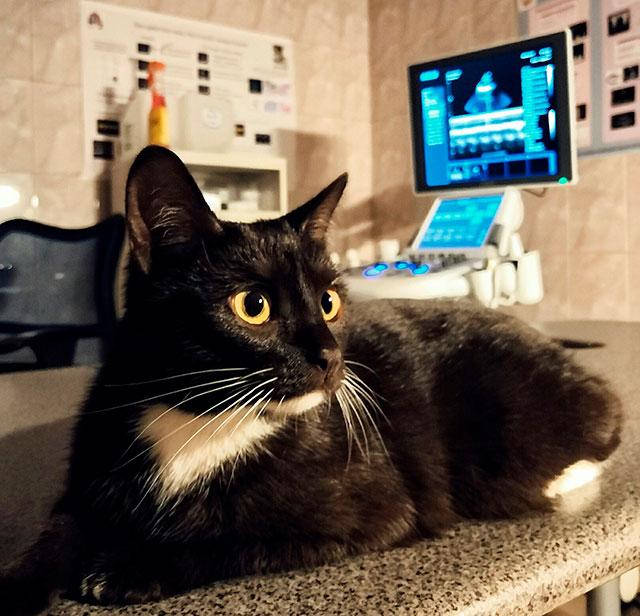
Treatment
Physiological tremor in cats does not require medical intervention. To eliminate it, it is enough to minimize stress factors, provide the animal with comfortable living conditions and a full balanced diet.
With regular attacks of tremor, the animal should be shown to a veterinary specialist.
Important! Do not independently relieve tremor attacks in cats with sedatives or antispasmodics designed for humans. This can provoke complications or blur the clinical picture of the disease, making it much more difficult to make a diagnosis.
Treatment of pathological tremor in cats is to eliminate the cause of its occurrence. It may be expressed in the prescription of sedatives, antihelminthic drugs. In the presence of infectious processes, antimicrobial and symptomatic therapy is carried out. In the presence of neoplasms, serious pathologies of the nervous or musculoskeletal system, surgical intervention is prescribed.
If the owner has noticed nervous twitching of the body in his cat, it is necessary to undergo a full course of examination in the clinic. This will help to identify the pathology in a timely manner and begin appropriate treatment. If the tremor is the result of improper nutrition or care, the veterinarian will point out the shortcomings and make adjustments that will further help to avoid the occurrence of tremors.
💡 A side note. More than half of your pet's health issues can be resolved remotely: by phone or online correspondence. On Veterinarian Online you can get a consultation with a specialist, quickly and without having to go to the veterinary clinic. The cost of the service: 399 rubles.
Diagnosis
To determine the reason why the cat's hind legs have failed, the veterinarian will first conduct a visual examination and determine the degree of sensitivity of the limbs. Then the animal will appoint the following laboratory tests:
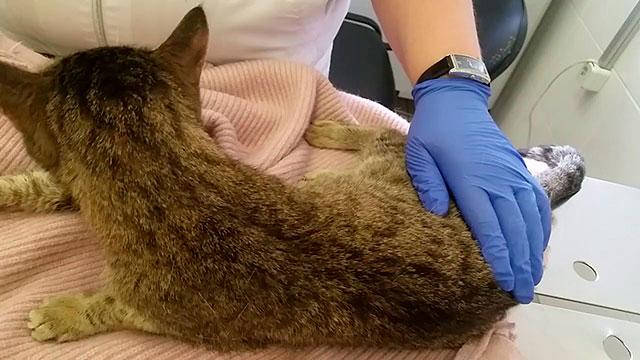
The cat will also undergo the following examinations based on the results of the visual examination:
- X-rays. It is mandatory for cats in case of various injuries, as well as in case of suspected joint diseases and cancer. Myelography, a separate type of radiological examination of the spine with the injection of a contrasting substance, may also be administered to the cat. The procedure helps detect herniated discs, neoplasms of the spinal cord, and other diseases.
- Measurement of intracranial and arterial pressure.
- Ultrasound and ECG of the heart.
- MRI and CT scans of the brain, abdomen and spine.
- Ultrasound of abdominal cavity organs.
Methods of treatment
The choice of treatment method directly depends on the cause that led to the failure of the hind legs. To successfully rid the cat of this ailment, the owners must strictly follow the prescriptions of the treating doctor.
- Surgical intervention. Usually the surgery is performed in the most extreme cases, when full recovery is impossible without it: in case of herniated intervertebral discs, spine injuries or, for example, in case of severe dysplasia. If the cat is diagnosed with oncological disease, it is also prescribed medication and radiation therapy.
- Diet. The cat may have to be put on a special diet and provide her with food that is rich in calcium, phosphorus, and other beneficial substances.
- Medication therapy. Depending on what condition the cat has been diagnosed with, different medications may be prescribed. For example, antibiotics, antispasmodics, analgesics, anti-inflammatory drugs, anticoagulants, chondroprotectors.
- Creating a special environment for the cat in the house. With some diseases, such as inflammation of the spinal cord, the cat should be placed in a dark, quiet place, to protect it from stress. In combination with medication therapy and physical therapy, such an environment will contribute to a quick recovery.
- Application of a cast. For fractures, severe bruises, or to correct the effects of dysplasia, a cast can be put on the cat, which will fix the limb in the correct position and speed up its recovery.
- Physical therapy.

Physical therapy treatments that can be prescribed by a doctor
A cat's recovery period after hind paw failure can take a long time. To speed it up, doctors often prescribe daily physical treatments for animals, which the owner can perform with the pet himself at home:





